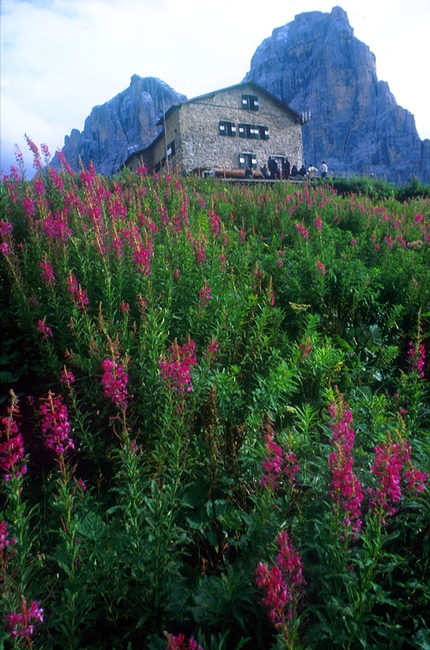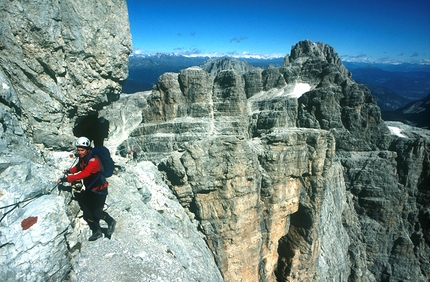Via Ferrata Bocchette Centrali - Cima Brenta Alta

 1 / 7
1 / 7 Planetmountain
Planetmountain





Together with the Via Ferrata delle Bocchette Alte the Via Ferrata delle Bocchette Centrali is rightly considered one of the most beautiful ferrate in the Brenta Dolomites. Crossing wild, exposed, but always well-equipped ledges, on clear days the view east extends from Lago di Molveno all the way to Civetta and the Marmolada, and west to Campanile Alto and the majestic Campanile Basso. Although a ferrata in its own right, it is also the natural second-day progression of the Via delle Bocchette Alte. After a night spent in one of the refuges, ideally Rifugio Alimonta, it guarantees an outing long to be remembered.
From Madonna di Campiglio drive to Rifugio Vallesinella (1513m).
AccessFrom Rifugio Vallesinella (1513m) take path no. 317 to Rifugio Casinei (1825m) and then continue on path no. 318 Sentiero dei Brentei in two hours to Rifugio dei Brentei (2182m). From here in one hour to Rifugio Alimonta (2580m).
ItineraryFrom Rifugio Alimonta (2580m) begin easily up path no. 323 past the Sfulmini glacier (care required on hard-packed snow in the morning) to the windy Bocca di Armi and the start of the Via Ferrata (30 mins). Reach the ledge after a few ladders and continue past cables onto the east face of Torre di Brenta. Exposed but finally sheltered from the wind, this is the true start of the long ledge traverse of the Bocchette Centrali. It soon leads to the most difficult section of the ferrata, the exciting horseshoe shaped ledge of the sentiero Figari. The sheer drop is staggering and the ledge is only 50cm wide at this point, but cables lead safely to beneath the Sfulmini, the impressive view onto Campanile Alto and the fantastic Campanile Basso. The path now leads downwards along the east face, around Campanile Alto (excellent rest point with view) to zigzag past wet boulders and across a small snow patch. Continue past this deep into the majestic world of the Brenta Dolomites to almost touch the mythical Campanile Basso, first climbed by the Austrians Ampferer and Berger in 1899. The silence is interrupted only by shouts from climbers high above and the wind which now blows across the col. Climb up the short but sometimes slippery slope to this saddle, to then descend right onto the west face of the Cima Brenta Alta. Polished steps and ladders lead down to another ledge: follow this easily and enjoy the splendid view onto Cima Tosa and Crozzon di Brenta to reach the final ladders and the glacier below.
DescentOnce on the glacier beneath the Bocca di Brenta return easily along Sentiero dei Brentei (no. 318) to Rifugio dei Brentei (2182m, 1 hour) and then on to Rifugio Vallesinella and the car park in a further 1.30 hours. Alternativly, climb up to Bocca di Brenta and descend to Rifugio Tommaso Pedrotti (2491m). This acts as a formidable base for other ferrate in the Brenta region, or as a well-deserved rest for those who chose to take the long path up from Molveno.
GearNormal via ferrata kit. Ice axe and crampons necessary at the start of the season
Maps/BibliographyVia Ferratas of the Italian Dolomites: Vol 2 by John Smith and Graham Fletcher. Cicerone Press 2002
DifficultyNot particularly difficult but exposed itinerary. Well-equipped throughout.
 Comments
Comments








 Copia link
Copia link Planetmountain.com
Planetmountain.com






 See all photos
See all photos
